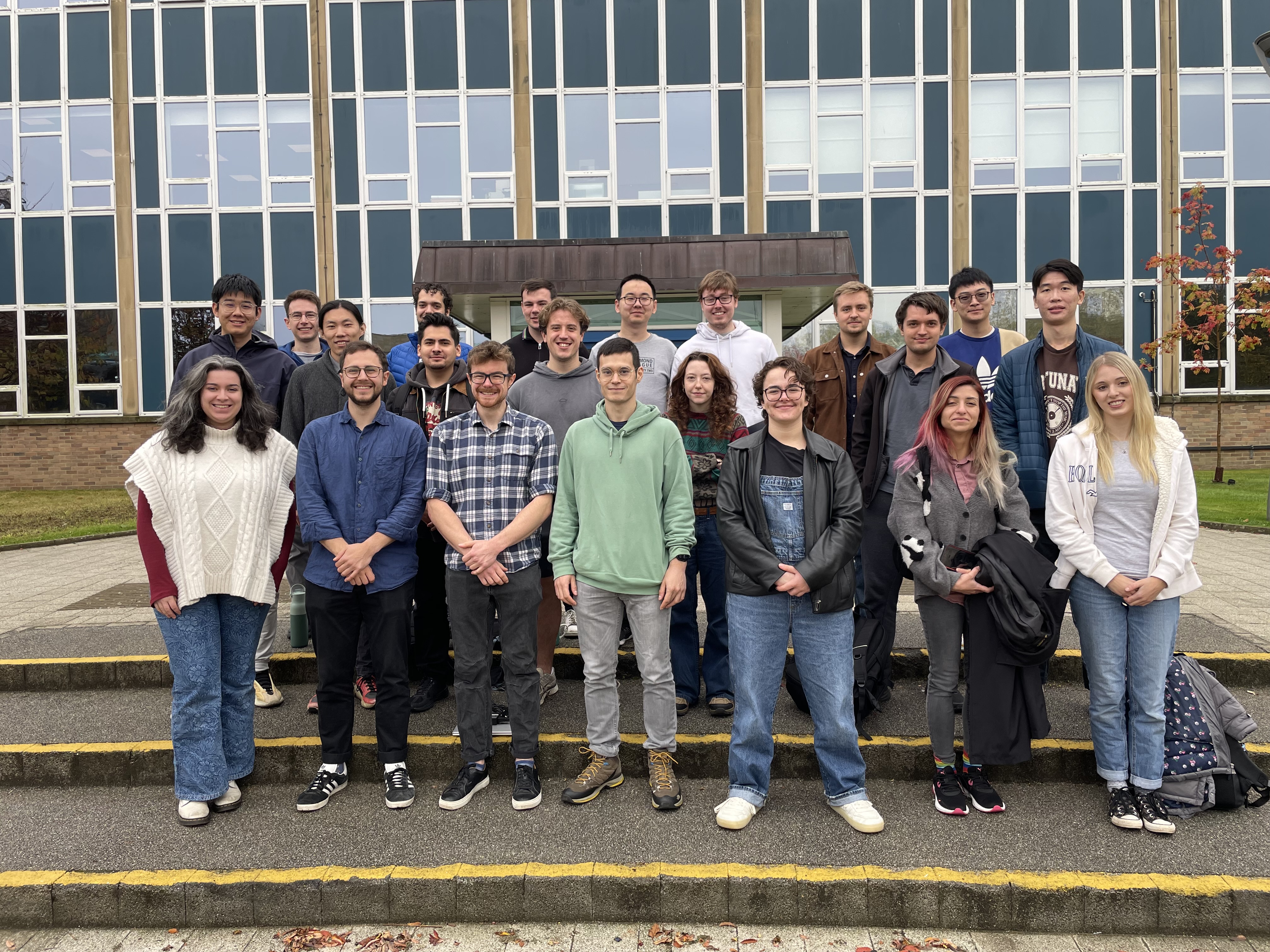 Current PhD students in the QLM group
Current PhD students in the QLM group
We have a selection of PhD projects available for an October 2026 start (listed below). If you are interested in any of these projects please contact the relevant supervisor directly, and register here to attend our open day on November 26th (11am-4pm). Registration deadline 21st November.
There are different mechanisms for funding a PhD, most common are:
Funded (the source of funding is already attached to the project).
Competition funded (the project is in competition for funding with other projects).
External scholarships (the student is in competition for funding, a list of scholarships can be found here).
If you join a project through any of these routes your university fees will be covered, and you will receive a tax-free stipend of £20,780 per year. Information regarding the application process can be found here. It is also possible to self-fund, please discuss this option directly with the supervisor.
Available Projects
We hope that you will join us and become a part of the QLM!
CYBER: Cs-Yb Error-Resilient Quantum ProcessorFunded (UK only)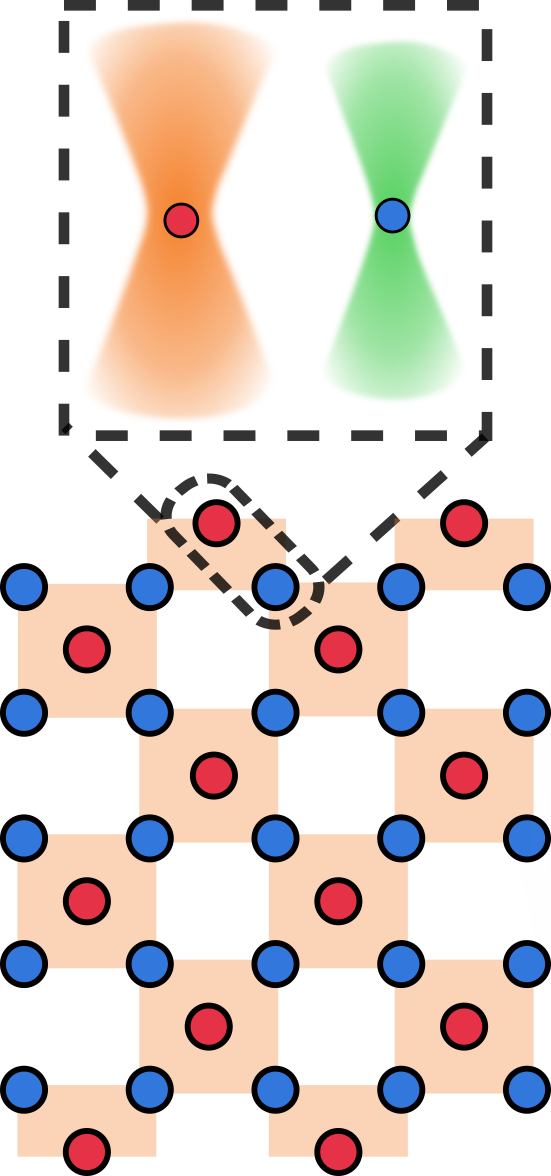 A central challenge in quantum computing is how to build large-scale, fault-tolerant machines that can solve problems impossible for classical computers. This requires precise control of qubits and the ability to suppress errors through quantum error correction.
A central challenge in quantum computing is how to build large-scale, fault-tolerant machines that can solve problems impossible for classical computers. This requires precise control of qubits and the ability to suppress errors through quantum error correction.
In this experimental project, you will help develop a new two-species optical-tweezer quantum computing platform using individually trapped caesium and ytterbium atoms. Tweezer arrays allow us to assemble quantum systems one atom at a time and generate strong, controllable interactions using Rydberg excitations. By combining two atomic species with very different properties, this platform enables low-crosstalk readout and high-fidelity entangling gates—all essential ingredients for error-corrected quantum processors. You will help develop the tools needed to create entanglement between Cs and Yb atoms—from setting up the laser systems that drive Rydberg excitations to implementing the protocols that entangle the atoms together. Through this you will learn core experimental skills in laser cooling, optical trapping and quantum-state control, forming an excellent foundation for a career in quantum technologies. 4-year NQCC Studentship: This position is a collaborative studentship between the University of Durham and the National Quantum Computing Centre. The position will be registered and hosted at the university, within the group of Dr. Alex Guttridge. The student will also have a co-supervisor at the NQCC who is an expert in the field. Over the course of the studentship students will be offered a minimum of three months to work at the NQCC with relevant research teams. This position is part of a wider cohort of 6 collaborative studentships within the NQCC’s Doctoral Studentship Scheme, where projects have been co-developed by the NQCC and different academic institutes across the UK. The scheme will include cohort-based training and activities, enabling students to gain wider skills and develop valuable personal and professional networks. For more information about the project, please see here. For any questions about the position, please contact Dr. Alex Guttridge. Back to table |
Single atoms and single photons – quantum networking with YbFunded (UK only)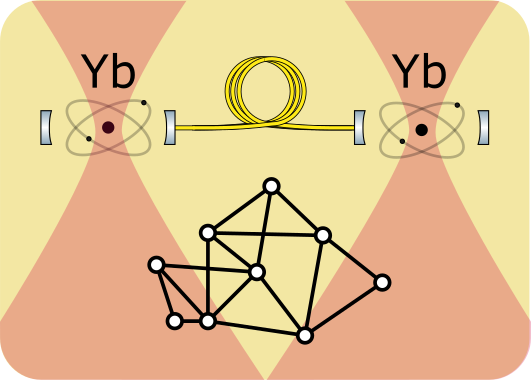 Single atoms, particularly ytterbium (Yb), in optical tweezers have emerged as a powerful platform for quantum computing, but scaling remains a barrier to practical quantum: while current devices can support thousands of qubits, estimates call for millions of qubits for many problems.
Single atoms, particularly ytterbium (Yb), in optical tweezers have emerged as a powerful platform for quantum computing, but scaling remains a barrier to practical quantum: while current devices can support thousands of qubits, estimates call for millions of qubits for many problems.
In this experimental project you will work on building one of the UK’s first arrays of Yb tweezers. As a unique feature this will integrate optical microcavities to efficiently capture single photons emitted from single atoms and couple them into standard telecom optical fibres. By performing measurements on these single photons entanglement between the atoms can be generated, forming a key building block for quantum networking. Eventually this will enable the connection of many arrays into large distributed quantum computing systems - just like today’s classical supercomputers are formed by many nodes in a network. This studentship is generously funded by a donation from Durham University alumni Dr. Rodney and Dr. Frances Stubbs. Further details about the project can be found here, for more information please contact Dr. Tobias Franzen. Back to table |
Machine learning techniques for improved experimental workflows in atomtronicsCompetition Funded (Worldwide)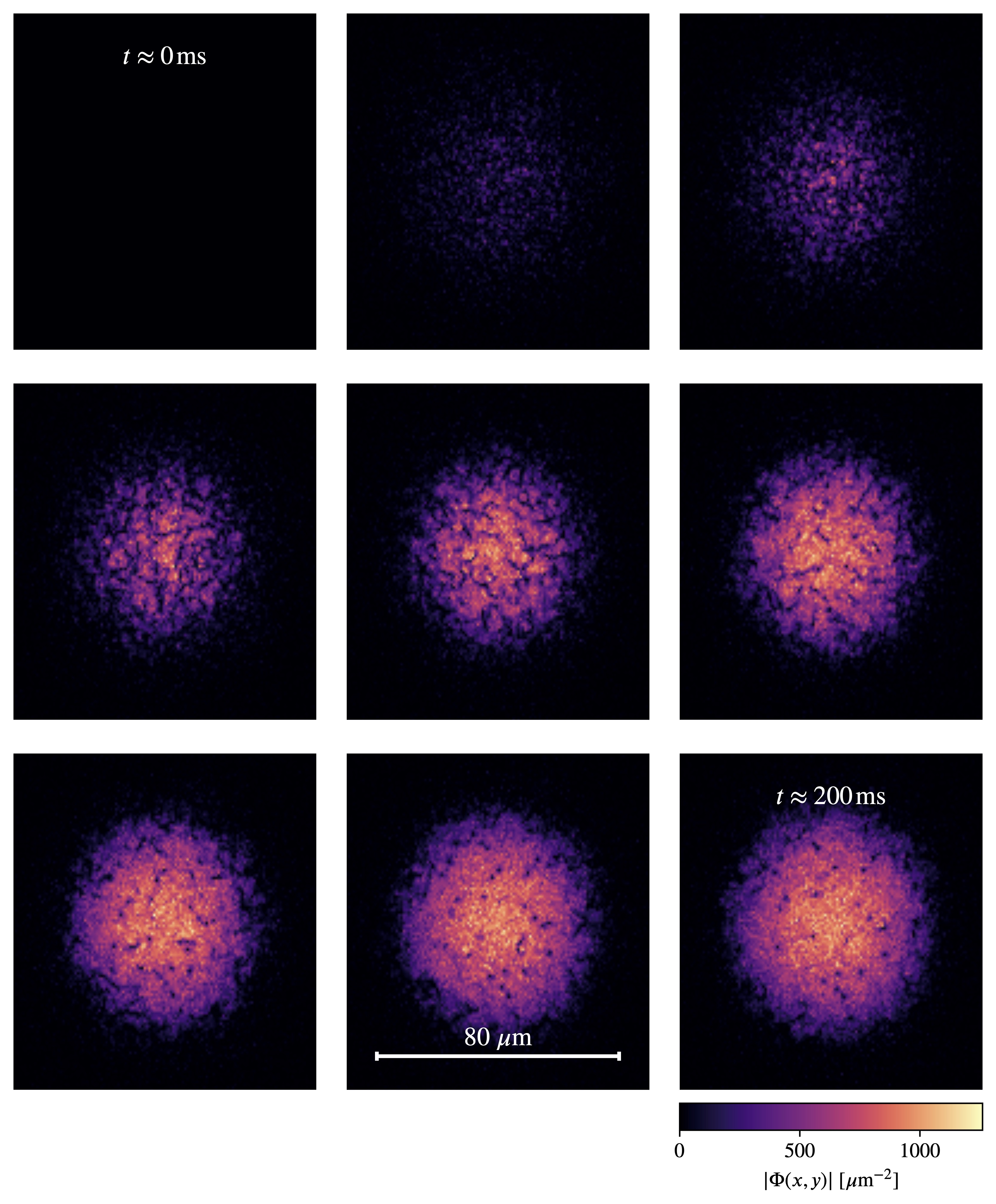 Bose-Einstein condensates (BECs) play a key role in emerging quantum technologies because they display quantum behaviour on a macroscopic scale. Realising their full potential in applications depends on the precise characterisation of their initial state, including their temperature and chemical potential. This presents a major challenge, as conventional measurement techniques are inherently destructive.
Bose-Einstein condensates (BECs) play a key role in emerging quantum technologies because they display quantum behaviour on a macroscopic scale. Realising their full potential in applications depends on the precise characterisation of their initial state, including their temperature and chemical potential. This presents a major challenge, as conventional measurement techniques are inherently destructive.We have recently developed a machine learning (ML) approach that could help overcomes this limitation, enabling rapid and non-destructive estimation of these key BEC properties. Our work suggest that machine learning can help to overcome these limitations in ultra-cold atom thermometry. This project involves developing these computational methods further which may lead to integration into experimental workflows. You will be trained in techniques that will enhance measurement precision and directly support the development of next-generation quantum devices, such as atom interferometers and other atomtronic applications. For further details about the position please contact Dr. Steven Wrathmall. Back to table |
Generating entangled photons using Rydberg excitonsFunded (UK only)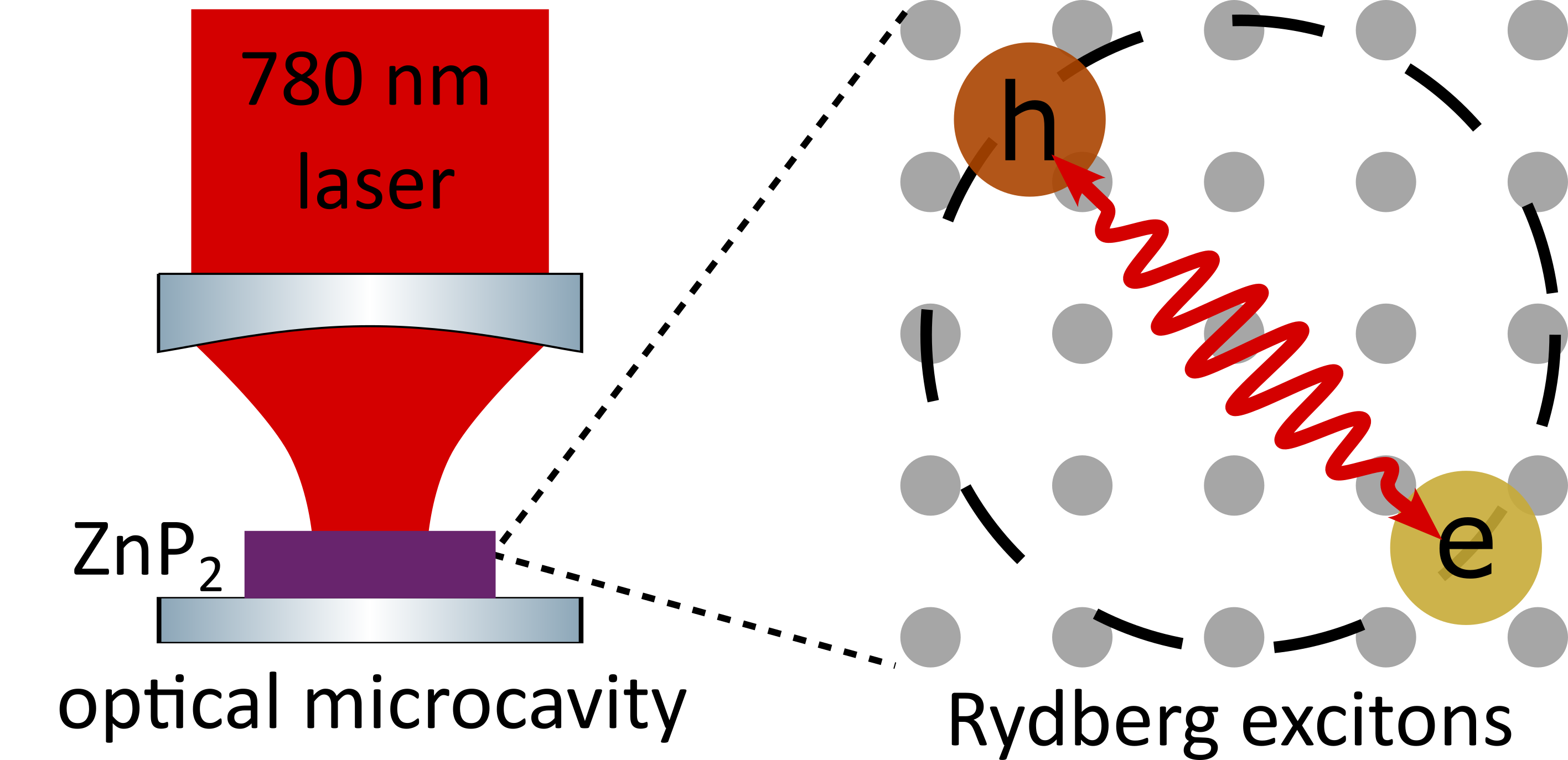 Photonic quantum computing is a promising platform for future for quantum information processing with companies in the UK and abroad pursing this approach. However, creating on-demand entanglement of photons is an open challenge which, if solved, would greatly improve the viability of photonic quantum information processing.
Photonic quantum computing is a promising platform for future for quantum information processing with companies in the UK and abroad pursing this approach. However, creating on-demand entanglement of photons is an open challenge which, if solved, would greatly improve the viability of photonic quantum information processing.
Here at Durham, we are using highly excited electron-hole pairs in semiconductors, known as Rydberg excitons, to address this problem. The large spatial extent of Rydberg excitons leads to enhanced interactions between them, which can be seen as optical nonlinearities. In this project you will integrate a low loss material for studying Rydberg excitons into an optical microcavity, with the aim of creating a large enough optical nonlinearity to entangle two photons. This studentship is generously funded by a donation from Durham University alumni Dr. Rodney and Dr. Frances Stubbs. For further details about the position please contact Dr. Liam Gallagher. Back to table |
Atomic clocks, optical lattices and ultracold moleculesFunded (UK only)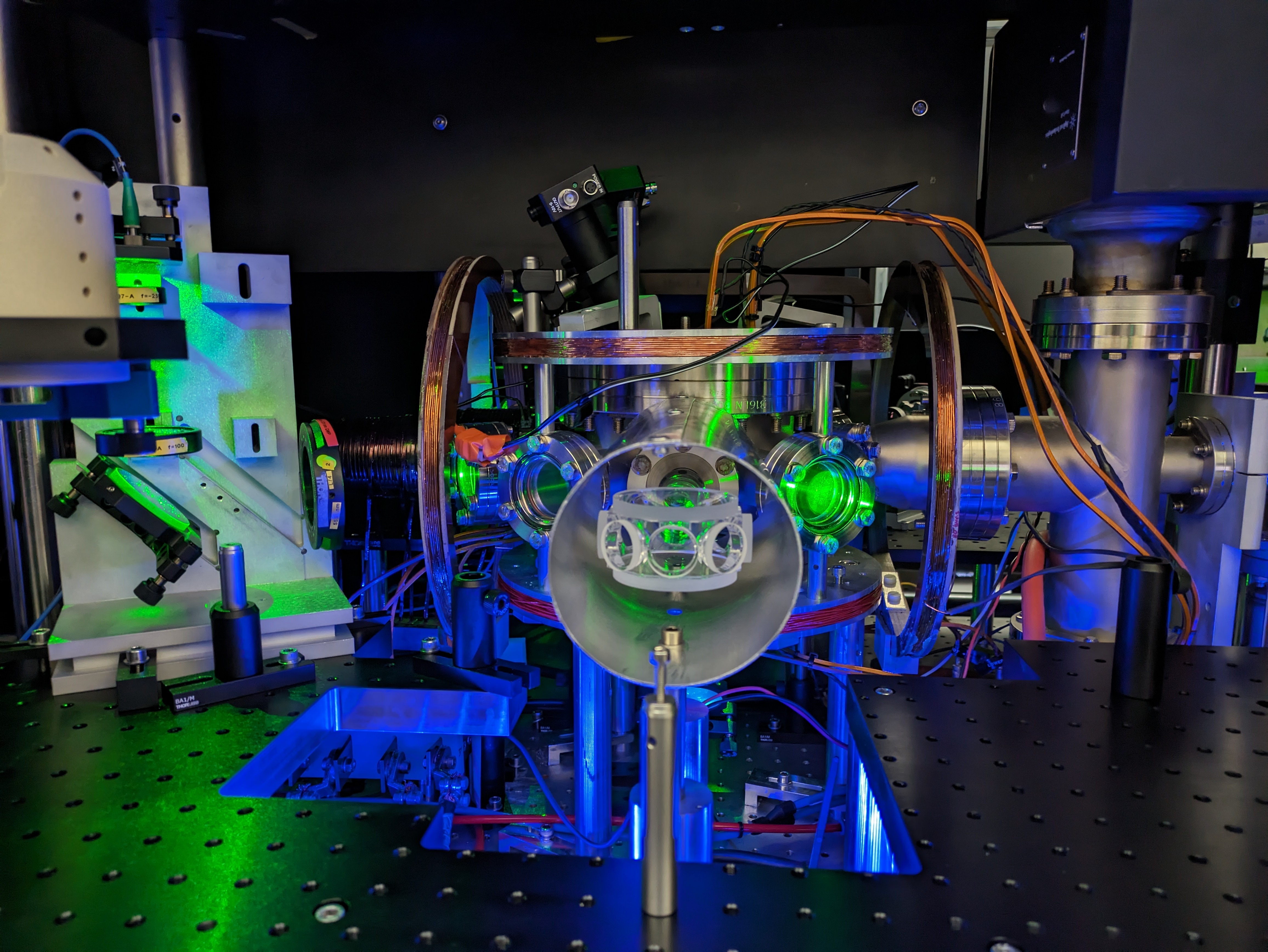 Ultracold polar molecules offer a wide range of exciting research directions spanning ultracold chemistry, precision measurement, quantum simulation and quantum computation. Numerous applications stem from the long-range dipolar interactions and rich internal structure of vibration and rotation. Enormous progress has been made in assembling pairs of alkali atoms to form bialkali molecules – including by our group in Durham using Rb and Cs. However, there is a need to diversify the range of molecules available. In this project you will use an existing and unique state-of-the-art experiment to form CsYb molecules. By combining an alkali atom (Cs) with closed-shell atom (Yb) you will form a molecule that has both an electric dipole moment and a magnetic dipole moment. Your strategy will be to utilize the metastable clock states in Yb where our theoretical work predicts relatively broad collision resonances with Cs that can be used to form molecules. You will also use a magic wavelength optical lattice and learn how to prepare Cs-Yb atom pairs in this lattice. Converting the atom pairs into molecules will realise a new and exciting platform for quantum simulation of many-body physics.
Ultracold polar molecules offer a wide range of exciting research directions spanning ultracold chemistry, precision measurement, quantum simulation and quantum computation. Numerous applications stem from the long-range dipolar interactions and rich internal structure of vibration and rotation. Enormous progress has been made in assembling pairs of alkali atoms to form bialkali molecules – including by our group in Durham using Rb and Cs. However, there is a need to diversify the range of molecules available. In this project you will use an existing and unique state-of-the-art experiment to form CsYb molecules. By combining an alkali atom (Cs) with closed-shell atom (Yb) you will form a molecule that has both an electric dipole moment and a magnetic dipole moment. Your strategy will be to utilize the metastable clock states in Yb where our theoretical work predicts relatively broad collision resonances with Cs that can be used to form molecules. You will also use a magic wavelength optical lattice and learn how to prepare Cs-Yb atom pairs in this lattice. Converting the atom pairs into molecules will realise a new and exciting platform for quantum simulation of many-body physics.
Details about the existing Cs-Yb project can be found here. For further details about the position please contact Prof. Simon Cornish. Back to table |
Bose-Einstein condensation of polar moleculesFunded (UK only)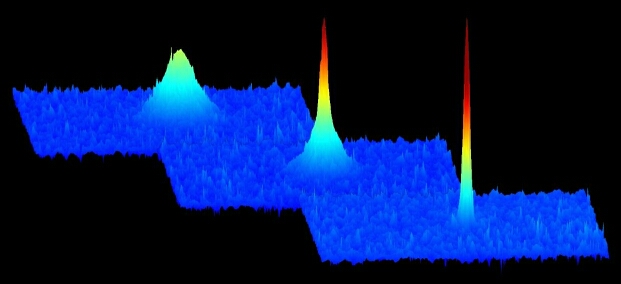 Bose-Einstein condensates of ultracold polar molecules have very recently emerged as an exciting new form of quantum matter characterized by strong dipolar interactions. This opens up many possibilities for studying novel quantum fluids and for preparing defect free arrays of molecules in optical lattices. In this project, you will join a team of researchers building a new state-of-the-art experimental apparatus to produce and study molecular Bose-Einstein condensates. The apparatus will incorporate a high-resolution imaging system capable of detecting single molecules and single sites of an optical lattice, placing it at the forefront of an exciting field. You will be trained in the state-of-the-art experimental techniques in laser-cooling, optical trapping of ultracold gases, formation of molecules and modern quantum physics – skills that are highly transferable. The project is part of a national programme on “Quantum many-body physics with ultracold polar molecules” funded by UKRI, presenting numerous opportunities to collaborate with other researchers in the UK and to engage with several international theory partners.
Bose-Einstein condensates of ultracold polar molecules have very recently emerged as an exciting new form of quantum matter characterized by strong dipolar interactions. This opens up many possibilities for studying novel quantum fluids and for preparing defect free arrays of molecules in optical lattices. In this project, you will join a team of researchers building a new state-of-the-art experimental apparatus to produce and study molecular Bose-Einstein condensates. The apparatus will incorporate a high-resolution imaging system capable of detecting single molecules and single sites of an optical lattice, placing it at the forefront of an exciting field. You will be trained in the state-of-the-art experimental techniques in laser-cooling, optical trapping of ultracold gases, formation of molecules and modern quantum physics – skills that are highly transferable. The project is part of a national programme on “Quantum many-body physics with ultracold polar molecules” funded by UKRI, presenting numerous opportunities to collaborate with other researchers in the UK and to engage with several international theory partners.
Details about this new project can be found here. For further details about the position please contact Prof. Simon Cornish. Back to table |
Visualizing strongly-focused 3D light fields in an atomic vapourCompetition Funded (Worldwide)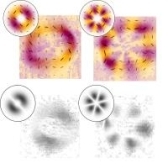 Strongly focused structured light generates highly confined vectorial electromagnetic field distributions, which may feature a polarization component along the optical axis. Despite statements found in some optics textbooks that light is a transverse wave, the real picture is more complicated. Axial components exist but manipulating and detecting such 3D light fields is challenging. Vector light can, however, be mapped onto atomic polarizations, making electric dipole transitions an ideal candidate to sense such 3D light configurations.
Strongly focused structured light generates highly confined vectorial electromagnetic field distributions, which may feature a polarization component along the optical axis. Despite statements found in some optics textbooks that light is a transverse wave, the real picture is more complicated. Axial components exist but manipulating and detecting such 3D light fields is challenging. Vector light can, however, be mapped onto atomic polarizations, making electric dipole transitions an ideal candidate to sense such 3D light configurations.
In this project you will join a team that is internationally leading on experiments in the field of spectroscopy of atomic vapours. The project is in collaboration with Glasgow University that provide world-leading expertise on shaped and structured light. You will be trained in the state-of-the-art techniques of atomic and quantum physics, quantum optics and photonics, and the interaction of atoms with strong magnetic fields. For further details about the position please contact Prof. Ifan Hughes. Back to table |
Next generation optical tweezersFunded (UK only)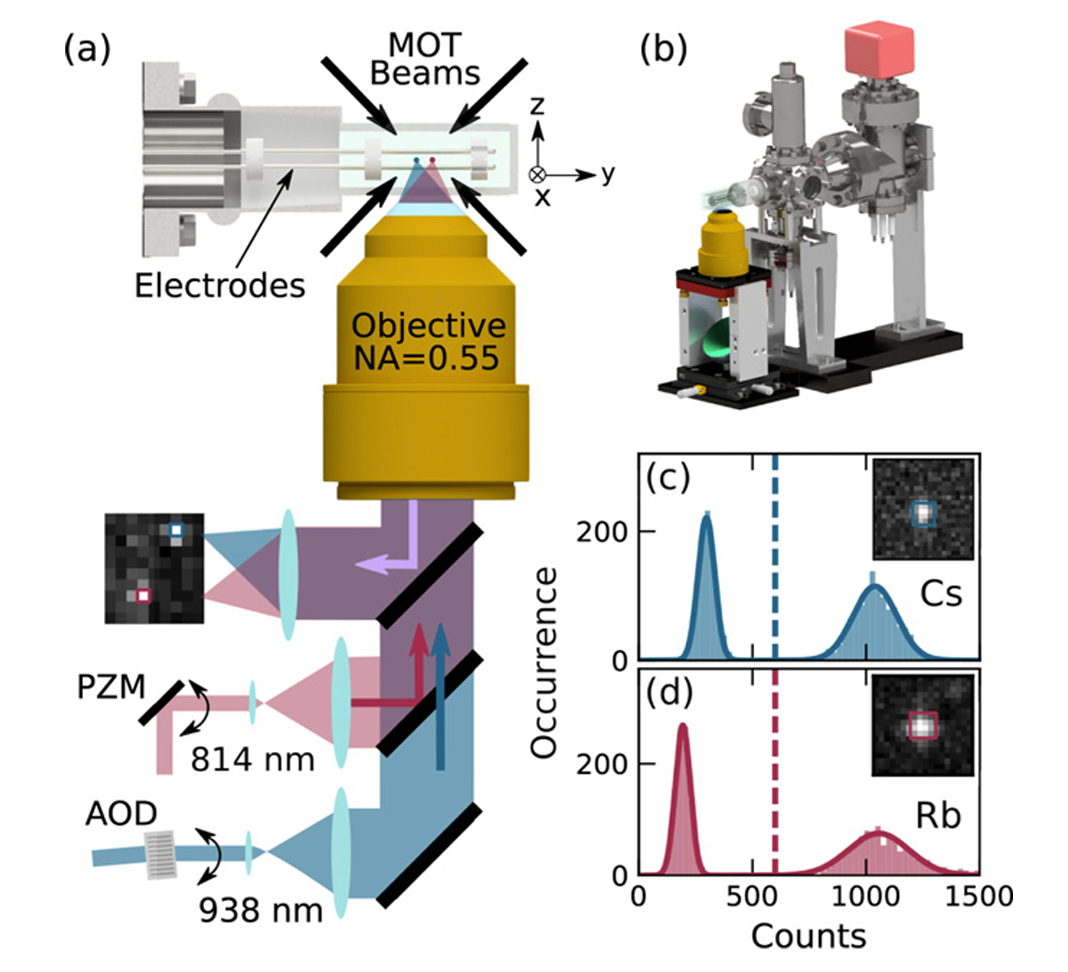 Single atom trapping and control with optical tweezers has become a major research theme throughout the world and many quantum startup companies are using this approach to develop platforms for quantum computation. In Durham we have an experiment that can trap single atoms of Rb and Cs in separate species-specific optical tweezers and then carefully combine them to form a molecule. The original apparatus is capable of forming up to 5 molecules in a linear array. In this project you will contribute to the construction of a second-generation apparatus aiming to produce interleaved 2D arrays of over 500 Rb and Cs atoms.
Single atom trapping and control with optical tweezers has become a major research theme throughout the world and many quantum startup companies are using this approach to develop platforms for quantum computation. In Durham we have an experiment that can trap single atoms of Rb and Cs in separate species-specific optical tweezers and then carefully combine them to form a molecule. The original apparatus is capable of forming up to 5 molecules in a linear array. In this project you will contribute to the construction of a second-generation apparatus aiming to produce interleaved 2D arrays of over 500 Rb and Cs atoms.
The use of two atomic species, rather than the single species employed in most experiments, enables independent control and crosstalk-free measurement of the two species, facilitating the mid-circuit qubit operations needed for quantum error correction. Additionally, the setup can also be used to create arrays of RbCs molecules. You will explore combining the tweezer array with optical lattices, firstly to enhance the efficiency of producing molecules and secondly to transfer the atoms or molecules into a the lattice to study tunnelling and many-body dynamics for these different systems. This 4-year project is partly funded by Pasqal a world-leading neutral-atom quantum computing company based in France. As part of this project you will have the opportunity to spend time in their Paris labs. For further details about the existing tweezer apparatus click here. For further details about the position please contact Dr. Hannah Williams. Back to table |
Optical arrays of CaF molecules for quantum simulationFunded (UK only)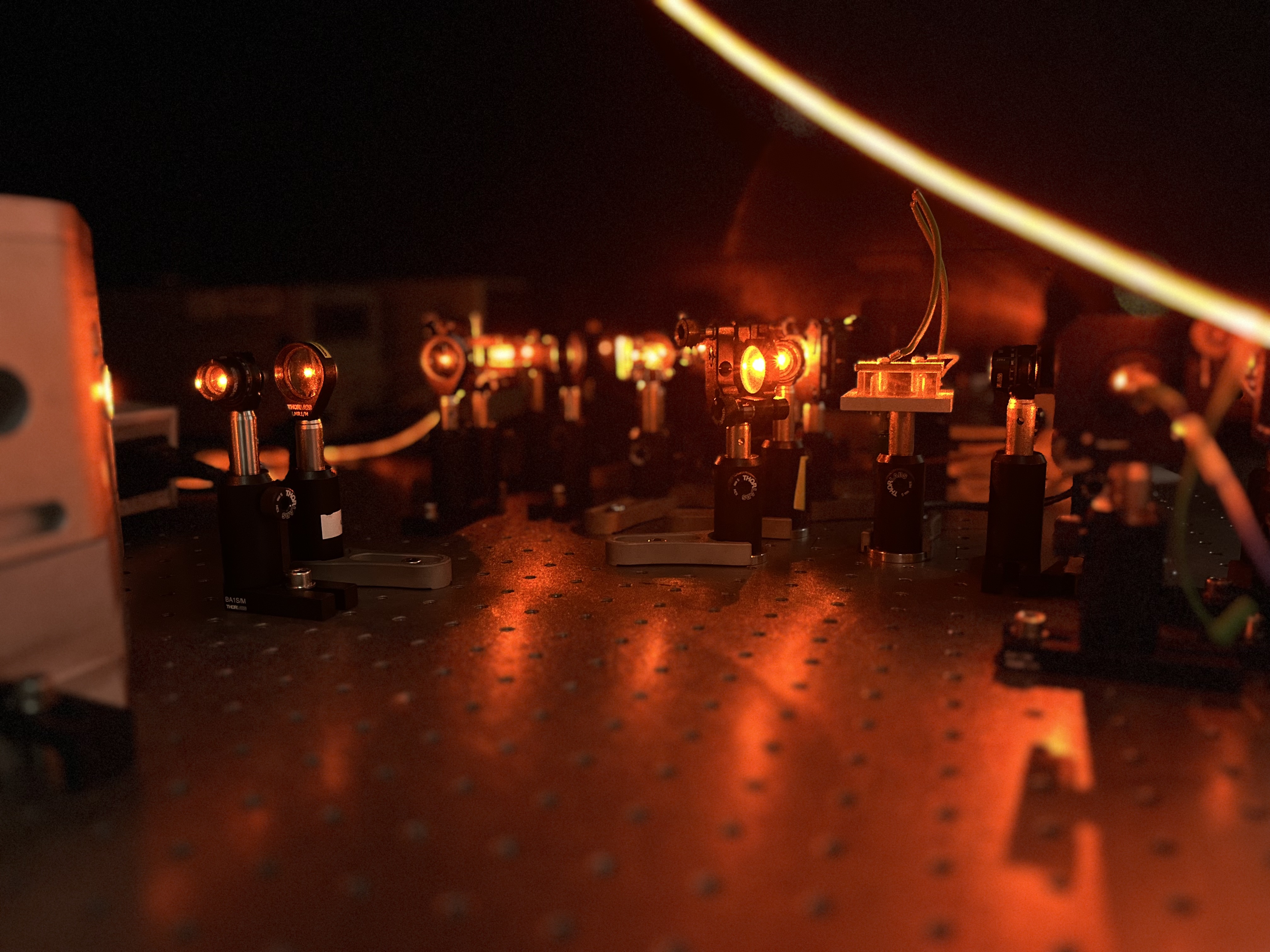 Cold, controlled molecules promise to provide a versatile platform for investigating quantum phenomena. In this project you will be joining an experimental team working on laser cooling calcium monofluoride molecules. The aim of the PhD will be to demonstrate interactions between individually trapped molecules. This is a highly experimental project during which you will learn skills in laser and vacuum technology, build an understanding of molecular physics and contribute to the rapidly expanding field of molecular quantum technology.
Cold, controlled molecules promise to provide a versatile platform for investigating quantum phenomena. In this project you will be joining an experimental team working on laser cooling calcium monofluoride molecules. The aim of the PhD will be to demonstrate interactions between individually trapped molecules. This is a highly experimental project during which you will learn skills in laser and vacuum technology, build an understanding of molecular physics and contribute to the rapidly expanding field of molecular quantum technology.
Find out more about this project here. For further details about the position please contact Dr. Hannah Williams. Back to table |
Omg – Yb qubit arraysCompetition funded (Worldwide)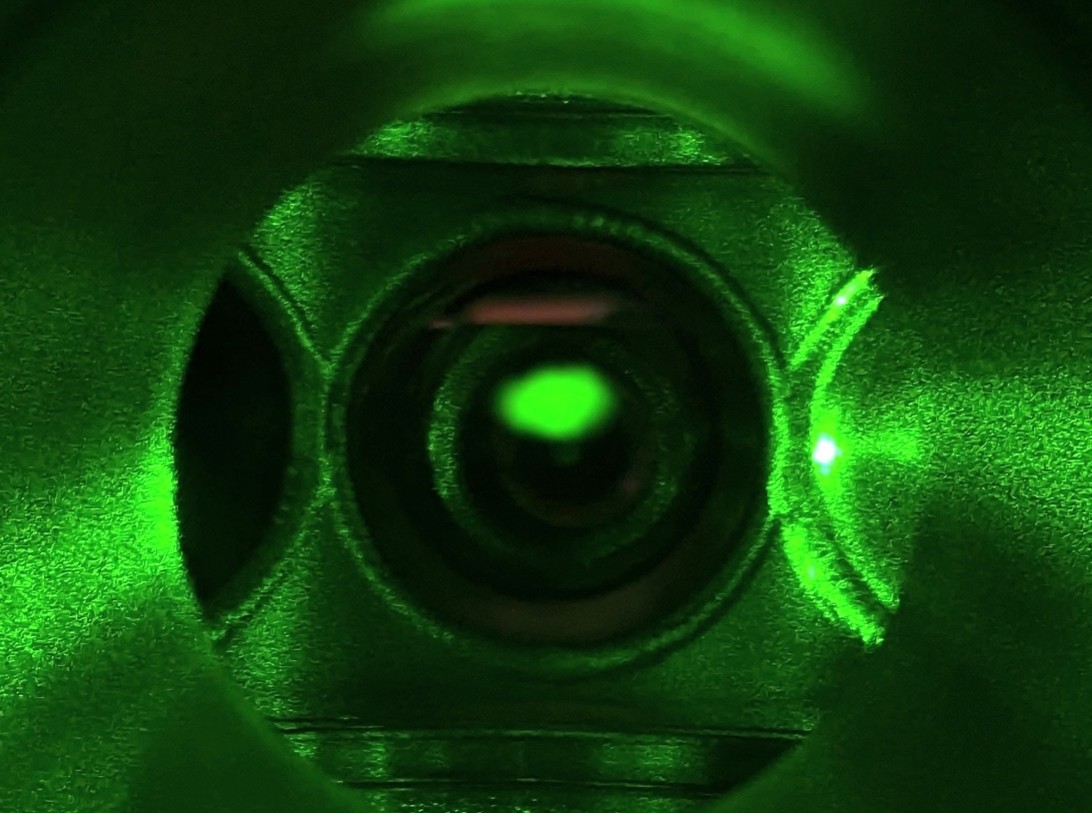 Arrays of single atoms trapped in optical tweezers and lattices offer exciting possibilities for quantum computing and quantum simulation. While currently most experiments choose alkali atoms for their relatively simple structure, it has emerged that species with more complicated structures are beneficial for many applications – an approach we are already pursuing with great success in our experiment with molecules. Ytterbium atoms feature a so-called omg (optical, metastable, ground state) architecture with three different possible qubit encodings – offering additional structure at greatly reduced experimental complexity compared to molecules. Combinations of these encodings can solve many challenges in neutral atom quantum computing, like the separation between storage and computation qubits and mid-circuit readout, which is essential for many error correction schemes.
Arrays of single atoms trapped in optical tweezers and lattices offer exciting possibilities for quantum computing and quantum simulation. While currently most experiments choose alkali atoms for their relatively simple structure, it has emerged that species with more complicated structures are beneficial for many applications – an approach we are already pursuing with great success in our experiment with molecules. Ytterbium atoms feature a so-called omg (optical, metastable, ground state) architecture with three different possible qubit encodings – offering additional structure at greatly reduced experimental complexity compared to molecules. Combinations of these encodings can solve many challenges in neutral atom quantum computing, like the separation between storage and computation qubits and mid-circuit readout, which is essential for many error correction schemes.
In this experimental project you will work on implementing this architecture in our existing CsYb apparatus, a first in the UK. By trapping single atoms in optical lattices at a magic wavelength you will form large arrays of qubits with second-scale coherence times, rearrange them at will using optical tweezers, and explore the possibilities of the omg-architecture. Details about the existing Cs-Yb project can be found here. For further details about the position please contact Prof. Simon Cornish. Back to table |
Quantum computing with atoms and molecules in optical tweezersFunded (UK only) Neutral atoms and molecules prepared in optical tweezers offer many exciting opportunities for quantum computing and quantum simulation. Most experiments work with either atoms or molecules. However, in this project, you will utilise both species to develop a new hybrid approach to quantum computing. Using an established world-leading optical tweezer apparatus (see image), you will construct an array of strongly interacting molecules and Rydberg atoms. You will learn how to engineer strong dipole-dipole interactions between individual atoms and molecules and then harness this interaction to address two of the key challenges in the field of ultracold molecules: (1) to perform non-destructive detection and state sensitive readout of the molecule, and (2) to realise fast high-fidelity entangling operations between molecules. These techniques will unlock the many advantages of molecules for quantum science and technology stemming from their rich internal structure.
Neutral atoms and molecules prepared in optical tweezers offer many exciting opportunities for quantum computing and quantum simulation. Most experiments work with either atoms or molecules. However, in this project, you will utilise both species to develop a new hybrid approach to quantum computing. Using an established world-leading optical tweezer apparatus (see image), you will construct an array of strongly interacting molecules and Rydberg atoms. You will learn how to engineer strong dipole-dipole interactions between individual atoms and molecules and then harness this interaction to address two of the key challenges in the field of ultracold molecules: (1) to perform non-destructive detection and state sensitive readout of the molecule, and (2) to realise fast high-fidelity entangling operations between molecules. These techniques will unlock the many advantages of molecules for quantum science and technology stemming from their rich internal structure.
Details about the existing tweezer apparatus can be found here. For further details about the position please contact Prof. Simon Cornish. Back to table |
Advanced space weather forecasting through atomic line filter developmentCompetition funded (Worldwide)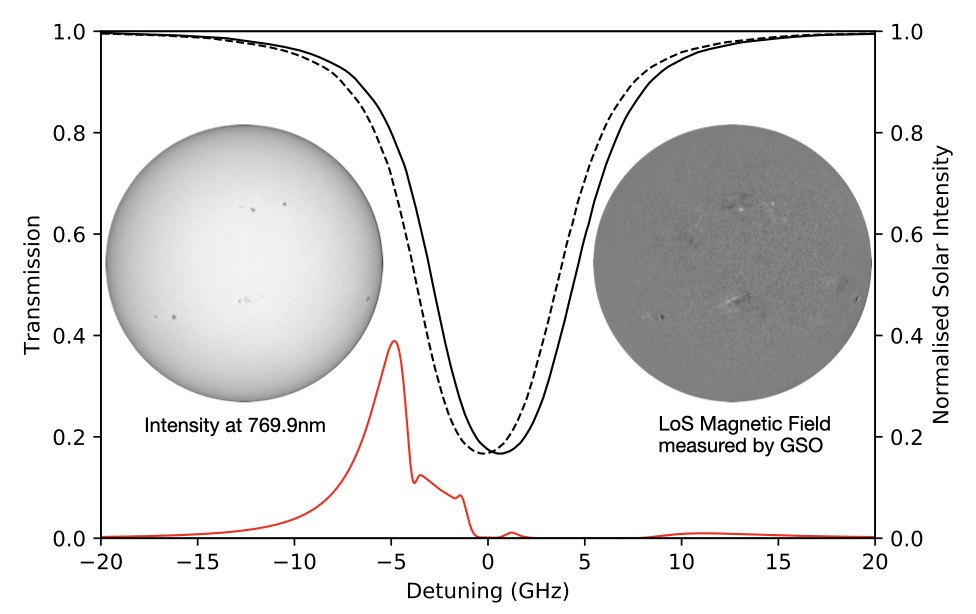 Adverse solar weather presents a major threat to critical infrastructure and the global economy. Mitigating this risk requires advanced space weather forecasts, which depends on accurately measuring the magnetic field strength within the solar atmosphere.
Adverse solar weather presents a major threat to critical infrastructure and the global economy. Mitigating this risk requires advanced space weather forecasts, which depends on accurately measuring the magnetic field strength within the solar atmosphere.
The Quantum Light and Matter Group at Durham University is a founding member of the SAMNET program, which is designed to provide real-time forecasting capabilities through a global network of solar telescopes. These telescopes are equipped with magneto-optical filters. The filters use a thermal atomic vapour (currently potassium) to measure solar magnetic fields. The next generation of these solar telescopes will exploit the properties of thermal vapours of other atomic species, which require further study and modelling. This project will build on our Group’s extensive work on modelling atom-light interactions within atomic vapours. Computational models will be developed to model atomic species of interest, building on our successful Elecsus software. The resulting models will be used to develop the next generation of magneto-optical filters, addressing a critical need towards advanced space weather forecasting. For further details about the position please contact Dr. Steven Wrathmall. Back to table |
A hybrid lattice-tweezer approach to quantum computingCompetition funded (UK only)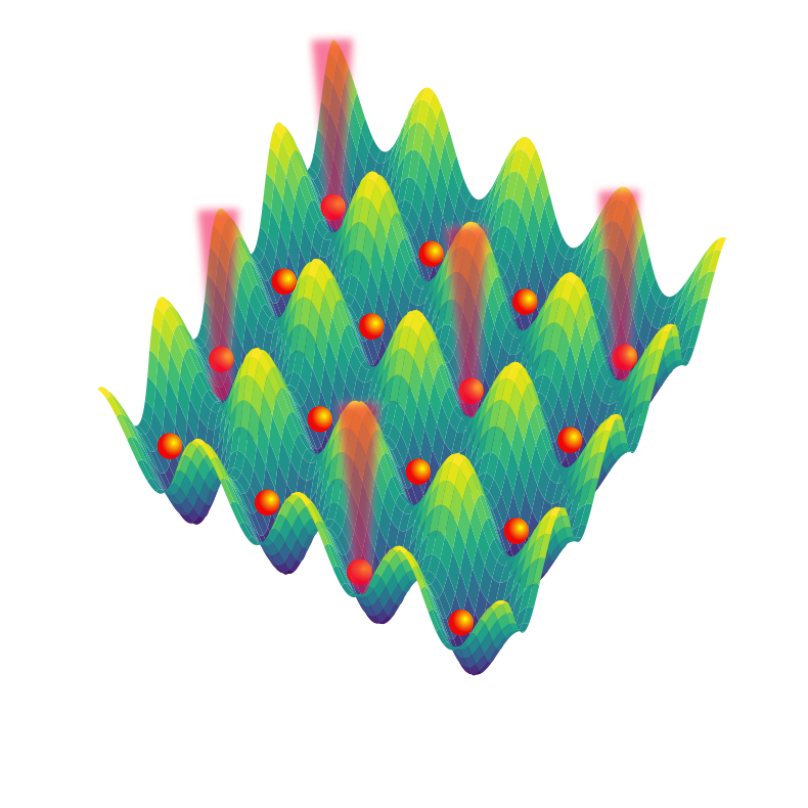 Optical tweezer arrays are quickly being established as a powerful platform for quantum computing and simulation due to the high levels of control they offer. Optical lattices promise to enable larger connectivity and increased evolution speed due to the close spacing of the lattice sites. In this project we are building a new experiment combining optical tweezers with lattices to explore a hybridized digital-analog approach to quantum computing. In this project you will learn technical skills in vacuum and laser systems as well as control software, data analysis and atomic physics theory.
Optical tweezer arrays are quickly being established as a powerful platform for quantum computing and simulation due to the high levels of control they offer. Optical lattices promise to enable larger connectivity and increased evolution speed due to the close spacing of the lattice sites. In this project we are building a new experiment combining optical tweezers with lattices to explore a hybridized digital-analog approach to quantum computing. In this project you will learn technical skills in vacuum and laser systems as well as control software, data analysis and atomic physics theory.
For further details about the position please contact Prof. Simon Cornish. Back to table |
Optical interface for superconducting qubits via Rydberg excitonsCompetition funded (Worldwide) Superconducting qubits are a leading platform for quantum information processing (QIP), with commercial players such as IBM and Google reaching > 1000 qubits. However there is currently no viable technology for the long-distance networking of superconducting quantum computers.
Superconducting qubits are a leading platform for quantum information processing (QIP), with commercial players such as IBM and Google reaching > 1000 qubits. However there is currently no viable technology for the long-distance networking of superconducting quantum computers.
At Durham (together with Cardiff University) we are pioneering a new approach based on Rydberg excitons – highly excited states of electron-hole pairs in a bulk semiconductor. These Rydberg excitons couple strongly to microwave and optical signals, which can be sent down an optical fibre to form a network. We have already demonstrated microwave-optical conversion at 4K [Gallagher et al., Phys. Rev. Res. 4, 013031 (2022)], and the highest microwave-optical nonlinearity of any material [Pritchett et al., APL Photonics 9, 031303 (2024)]. In this project you will extend these techniques to couple Rydberg excitons to superconducting quantum circuits. You will explore their integration with optical fibres and waveguides, and optimize the conversion process to approach the quantum regime required for future networks. For further details about the position please contact Prof. Matthew Jones. Back to table |
Quantum walks, graphs, climate, and financeCompetition funded (Worldwide) In this project we shall look at applications of quantum physics to topics in finance and climate. This could include optimisation problems, related to for example our recent work on graph colouring [1] or quantum walks. The project will be mainly computational.
In this project we shall look at applications of quantum physics to topics in finance and climate. This could include optimisation problems, related to for example our recent work on graph colouring [1] or quantum walks. The project will be mainly computational.
Quantum walks (QWs) are particularly interesting in that they can exhibit both positive and negative feedback resulting in very different probability distributions to classical random walks [2,3]. In particular, after a few steps there is a higher probability of wide departures from the mean, and hence the prediction of extreme events. Our recent focus has been on studying quantum walks in the context of sudden market crashes [4]. For further details about the position please contact Prof. Stuart Adams. References: [1] Graph Coloring via Quantum Optimization on a Rydberg-Qudit Atom Array, Toonyawat Angkhanawin, Aydin Deger, Jonathan D. Pritchard, C. Stuart Adams, https://arxiv.org/abs/2504.08598 [2] Quantum Walk Computing: Theory, Implementation, and Application, X. Qiang et al, Intell. Comput. 3, 0097 (2024). - url: https://spj.science.org/doi/10.34133/icomputing.0097 [3] Quantum Walks of Correlated Photons, A. Peruzzo et al, Science 329, 1500 (2010). - url: https://www.science.org/doi/10.1126/science.1193515 [4] A discrete-time quantum walk model of extreme market events: a complexity-based approach, C Stuart Adams, Arze Karam, Christopher McCarty, and Jack Waller, submitted (contact the authors) Back to table |
Quantum spin dynamics with ultracold polar molecules under the microscopeFunded (UK only) Understanding quantum materials containing many interacting particles is one of the greatest challenges in modern physics. A promising way to address this challenge is to construct an artificial quantum system and use it to simulate the properties of a more complex system found in nature – an approach known as quantum simulation. In this project, you will use arrays of ultracold polar molecules confined in optical lattices as a quantum simulator. Using microwave fields to control the internal state of the molecules, you will encode spins in the molecules and engineer dipolar interactions between them. Using these techniques, you will generate and study models of quantum magnetism and exotic many-body phenomena. To detect entanglement, correlations and dynamics in the system, you will use a novel quantum gas microscope that enables the detection of both the position and state of individual molecules in the lattice (see image).
Understanding quantum materials containing many interacting particles is one of the greatest challenges in modern physics. A promising way to address this challenge is to construct an artificial quantum system and use it to simulate the properties of a more complex system found in nature – an approach known as quantum simulation. In this project, you will use arrays of ultracold polar molecules confined in optical lattices as a quantum simulator. Using microwave fields to control the internal state of the molecules, you will encode spins in the molecules and engineer dipolar interactions between them. Using these techniques, you will generate and study models of quantum magnetism and exotic many-body phenomena. To detect entanglement, correlations and dynamics in the system, you will use a novel quantum gas microscope that enables the detection of both the position and state of individual molecules in the lattice (see image).
You will join a team of researchers working on our established RbCs quantum gas microscope experiment in Durham and will be trained in the state-of-the-art experimental techniques in laser-cooling, ultracold gases and quantum physics. The project is part of a national programme on “Quantum many-body physics with ultracold polar molecules” funded by UKRI, presenting numerous opportunities to collaborate with other researchers in the UK and to engage with several international theory partners. Details about the existing RbCs quantum gas microscope experiment can be found here. For further details about the position please contact Prof. Simon Cornish. Back to table |
ODD: Overwhelmingly dipolar diatomicsCompetition funded (Worldwide) Ultracold polar molecules have many applications, in particular for quantum simulation and the realisation of novel quantum phases. Perhaps the most important feature of these molecules is their dipole moment that can be used to engineer controlled interactions over long range. We are developing a new experiment to prepare an ultracold mixture of silver (Ag) and rubidium (Rb) atoms. Using this apparatus, we will study collisions between the two atomic species, and by controlling those collisions associate atoms to form rubidium-silver (RbAg) molecules. These molecules are of great current interest as they possess a very large dipole moment, and would enable long-range dipolar interactions to be engineered in the ultracold gas that are 1-2 orders of magnitude greater than are accessible in current experiments.
Ultracold polar molecules have many applications, in particular for quantum simulation and the realisation of novel quantum phases. Perhaps the most important feature of these molecules is their dipole moment that can be used to engineer controlled interactions over long range. We are developing a new experiment to prepare an ultracold mixture of silver (Ag) and rubidium (Rb) atoms. Using this apparatus, we will study collisions between the two atomic species, and by controlling those collisions associate atoms to form rubidium-silver (RbAg) molecules. These molecules are of great current interest as they possess a very large dipole moment, and would enable long-range dipolar interactions to be engineered in the ultracold gas that are 1-2 orders of magnitude greater than are accessible in current experiments.
For further details about the position please contact Dr. Phil Gregory. Back to table |